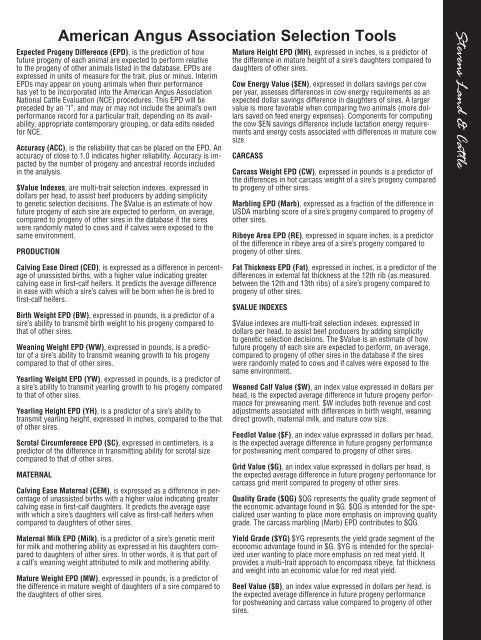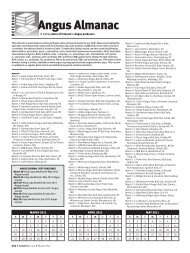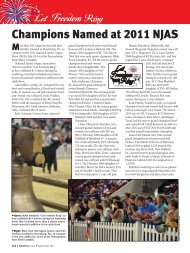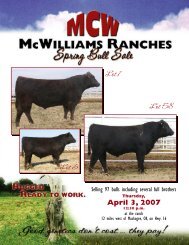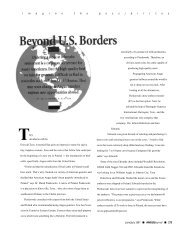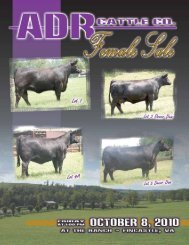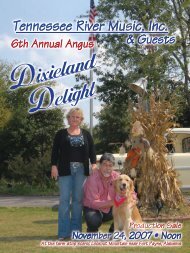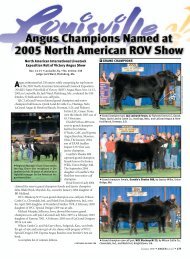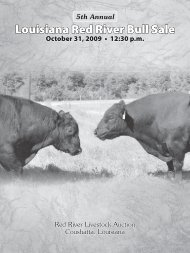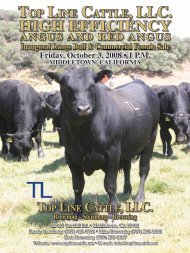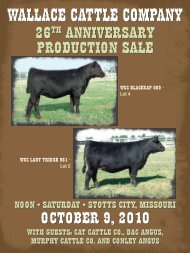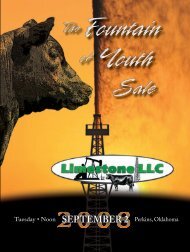Stevens Land & Cattle - Angus Journal
Stevens Land & Cattle - Angus Journal
Stevens Land & Cattle - Angus Journal
Create successful ePaper yourself
Turn your PDF publications into a flip-book with our unique Google optimized e-Paper software.
American <strong>Angus</strong> Association Selection Tools<br />
Expected Progeny Difference (EPD), is the prediction of how<br />
future progeny of each animal are expected to perform relative<br />
to the progeny of other animals listed in the database. EPDs are<br />
expressed in units of measure for the trait, plus or minus. Interim<br />
EPDs may appear on young animals when their performance<br />
has yet to be incorporated into the American <strong>Angus</strong> Association<br />
National <strong>Cattle</strong> Evaluation (NCE) procedures. This EPD will be<br />
preceded by an “I”, and may or may not include the animal’s own<br />
performance record for a particular trait, depending on its availability,<br />
appropriate contemporary grouping, or data edits needed<br />
for NCE.<br />
Accuracy (ACC), is the reliability that can be placed on the EPD. An<br />
accuracy of close to 1.0 indicates higher reliability. Accuracy is impacted<br />
by the number of progeny and ancestral records included<br />
in the analysis.<br />
$Value Indexes, are multi-trait selection indexes, expressed in<br />
dollars per head, to assist beef producers by adding simplicity<br />
to genetic selection decisions. The $Value is an estimate of how<br />
future progeny of each sire are expected to perform, on average,<br />
compared to progeny of other sires in the database if the sires<br />
were randomly mated to cows and if calves were exposed to the<br />
same environment.<br />
PRODUCTION<br />
Calving Ease Direct (CED), is expressed as a difference in percentage<br />
of unassisted births, with a higher value indicating greater<br />
calving ease in first-calf heifers. It predicts the average difference<br />
in ease with which a sire’s calves will be born when he is bred to<br />
first-calf heifers.<br />
Birth Weight EPD (BW), expressed in pounds, is a predictor of a<br />
sire’s ability to transmit birth weight to his progeny compared to<br />
that of other sires.<br />
Weaning Weight EPD (WW), expressed in pounds, is a predictor<br />
of a sire’s ability to transmit weaning growth to his progeny<br />
compared to that of other sires.<br />
Yearling Weight EPD (YW), expressed in pounds, is a predictor of<br />
a sire’s ability to transmit yearling growth to his progeny compared<br />
to that of other sires.<br />
Yearling Height EPD (YH), is a predictor of a sire’s ability to<br />
transmit yearling height, expressed in inches, compared to the that<br />
of other sires.<br />
Scrotal Circumference EPD (SC), expressed in centimeters, is a<br />
predictor of the difference in transmitting ability for scrotal size<br />
compared to that of other sires.<br />
MATERNAL<br />
Calving Ease Maternal (CEM), is expressed as a difference in percentage<br />
of unassisted births with a higher value indicating greater<br />
calving ease in first-calf daughters. It predicts the average ease<br />
with which a sire’s daughters will calve as first-calf heifers when<br />
compared to daughters of other sires.<br />
Maternal Milk EPD (Milk), is a predictor of a sire’s genetic merit<br />
for milk and mothering ability as expressed in his daughters compared<br />
to daughters of other sires. In other words, it is that part of<br />
a calf’s weaning weight attributed to milk and mothering ability.<br />
Mature Weight EPD (MW), expressed in pounds, is a predictor of<br />
the difference in mature weight of daughters of a sire compared to<br />
the daughters of other sires.<br />
Mature Height EPD (MH), expressed in inches, is a predictor of<br />
the difference in mature height of a sire’s daughters compared to<br />
daughters of other sires.<br />
Cow Energy Value ($EN), expressed in dollars savings per cow<br />
per year, assesses differences in cow energy requirements as an<br />
expected dollar savings difference in daughters of sires. A larger<br />
value is more favorable when comparing two animals (more dollars<br />
saved on feed energy expenses). Components for computing<br />
the cow $EN savings difference include lactation energy requirements<br />
and energy costs associated with differences in mature cow<br />
size.<br />
CARCASS<br />
Carcass Weight EPD (CW), expressed in pounds is a predictor of<br />
the differences in hot carcass weight of a sire’s progeny compared<br />
to progeny of other sires.<br />
Marbling EPD (Marb), expressed as a fraction of the difference in<br />
USDA marbling score of a sire’s progeny compared to progeny of<br />
other sires.<br />
Ribeye Area EPD (RE), expressed in square inches, is a predictor<br />
of the difference in ribeye area of a sire’s progeny compared to<br />
progeny of other sires.<br />
Fat Thickness EPD (Fat), expressed in inches, is a predictor of the<br />
differences in external fat thickness at the 12th rib (as measured<br />
between the 12th and 13th ribs) of a sire’s progeny compared to<br />
progeny of other sires.<br />
$VALUE INDEXES<br />
$Value indexes are multi-trait selection indexes, expressed in<br />
dollars per head, to assist beef producers by adding simplicity<br />
to genetic selection decisions. The $Value is an estimate of how<br />
future progeny of each sire are expected to perform, on average,<br />
compared to progeny of other sires in the database if the sires<br />
were randomly mated to cows and if calves were exposed to the<br />
same environment.<br />
Weaned Calf Value ($W), an index value expressed in dollars per<br />
head, is the expected average difference in future progeny performance<br />
for preweaning merit. $W includes both revenue and cost<br />
adjustments associated with differences in birth weight, weaning<br />
direct growth, maternal milk, and mature cow size.<br />
Feedlot Value ($F), an index value expressed in dollars per head,<br />
is the expected average difference in future progeny performance<br />
for postweaning merit compared to progeny of other sires.<br />
Grid Value ($G), an index value expressed in dollars per head, is<br />
the expected average difference in future progeny performance for<br />
carcass grid merit compared to progeny of other sires.<br />
Quality Grade ($QG) $QG represents the quality grade segment of<br />
the economic advantage found in $G. $QG is intended for the specialized<br />
user wanting to place more emphasis on improving quality<br />
grade. The carcass marbling (Marb) EPD contributes to $QG.<br />
Yield Grade ($YG) $YG represents the yield grade segment of the<br />
economic advantage found in $G. $YG is intended for the specialized<br />
user wanting to place more emphasis on red meat yield. It<br />
provides a multi-trait approach to encompass ribeye, fat thickness<br />
and weight into an economic value for red meat yield.<br />
Beef Value ($B), an index value expressed in dollars per head, is<br />
the expected average difference in future progeny performance<br />
for postweaning and carcass value compared to progeny of other<br />
sires.<br />
<strong>Stevens</strong> <strong>Land</strong> & <strong>Cattle</strong>


